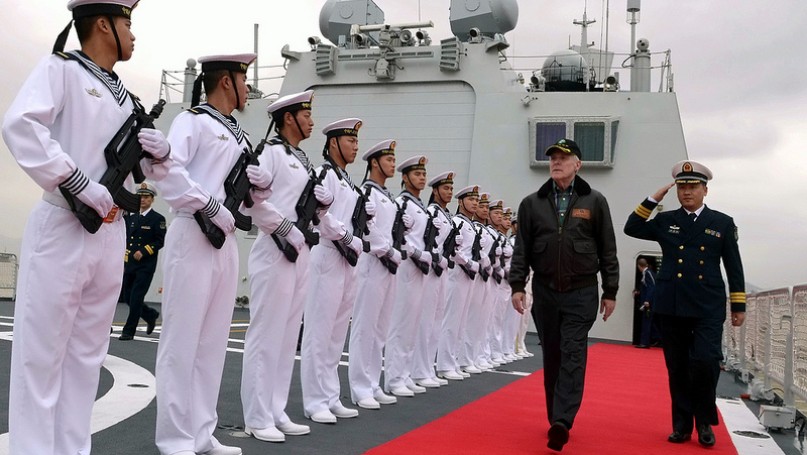
A lot of discussion has taken place on China’s military modernization efforts of late. And for good reason. China has already revealed prototypes of its stealth aircraft and also made some important strides towards a blue-water naval force, exemplified by the refurbished Liaoning aircraft carrier and recent plans for additional indigenously-built carriers.
China also surprised observers with its reported testing of a hypersonic glide vehicle in early 2014 – technology meant to provide extremely fast and difficult to counter long-range missiles. If true, it means that China’s much feared anti-ship ballistic missile (ASBM) might not be the last word when it comes to its already formidable conventional missile force.
There’s no denying that China has made some important progress in building its military capabilities. Yet it’s important not to overstate things. China’s military has a much more formidable edge, which can be felt most acutely in its immediate “near seas.” But it may be premature to consider the maritime zone behind the first island chain a “no man’s land” for rival military powers – not least the United States.
For one, China can do relatively little to prevent submarines from other nations entering its near seas. The reason is simple. China’s capacity for anti-submarine warfare (ASW) is weak, especially against America’s highly capable nuclear submarines. Japan’s advanced diesel submarines would also prove difficult targets, due to their silence and relative endurance enabled by air-independent propulsion technology.
To be sure, US and Japanese submarines would also have limited ASW utility in these waters (PDF). China can more easily contest the surrounding airspace, so any potential adversary won’t be able to so easily rely on surface and air-based ASW platforms. Another complication is the littoral’s shallow depths and poor acoustics, which could help conceal Chinese submarines. Yet these conditions also work both ways, meaning that China will also be hampered in its own modest ASW efforts here. As a result, China’s surface fleet, submarine bases, and potentially key coastal targets would be dangerously exposed to anti-ship and land attacks from these undersea warships.
Another factor that shouldn’t be ignored is the People’s Liberation Army’s (PLA) lack of operational experience. Little is really known about how the PLA will function in a combat environment. It’s one thing to count the number of new warships, fighter aircraft, and advanced ballistic and cruise missiles in China’s inventory. It’s another to judge the military effectiveness of its “strike-reconnaissance” complex, for example. This is especially true against a well-armed, highly professional, and operationally proficient military, like the one the US has built over the years.
Some of this uncertainty is technological. For example, the PLA has incorporated advanced features on many new military designs, from stealth coating on aircraft to phased array radar and vertical launchers on warships. But we know little about the quality of these technologies or the actual capabilities offered by these newer designs. Even less is known about how well the PLA can operate such platforms – although the modest training flight time allocated to pilots and the navy’s limited submarine experience makes it hard to be optimistic.
The PLA’s operational deficiencies may even be magnified in coming years, due precisely to its growing arsenal of advanced weapon systems. Aircraft carriers can bring some unique capabilities like carrier aviation, for example. But they also involve a high degree of complexity in their operations that will prove difficult to master. The same can be said of submarines. Even the ballyhooed ASBM relies on a host of cueing and tracking systems to reach its target. And many things can easily go wrong along its “kill-chain,” not least from an adversary’s active and passive efforts to disrupt this sequence.
Yet this difficulty only increases when dealing with complex operations involving multiple platforms – a good example being ASW involving air and sea assets. Even more challenging would be if China actually tries to implement an anti-access and area-denial stratagem, involving the joint application of naval assets and shore-based air and missile forces against a sophisticated opponent with key offense/defence capabilities.
The last point is an important one, as it underlines the fact that China’s military capabilities can only be measured against those of an adversary doing its utmost to counter any such advantages. With the Americans, it is also dealing with a military that is both more formidable in many key metrics, from platform capabilities to technological know-how and training, and has shown a remarkable degree of ingenuity countering so-called asymmetrical “game-changers” like the ASBM – meaning that we shouldn’t count out the US military just yet.
Further Reading on E-International Relations
- Opinion – Rethinking the China Challenge
- Opinion – Emerging Elements of a New US-China Cold War
- Opinion – China and the US in Israel: The Lucrative Versus the Indispensable?
- Opinion – US Export Controls and China’s Semiconductor Industry
- Opinion – The Future of the USA-China Trade War
- The Complex Dance of US-China Climate Cooperation